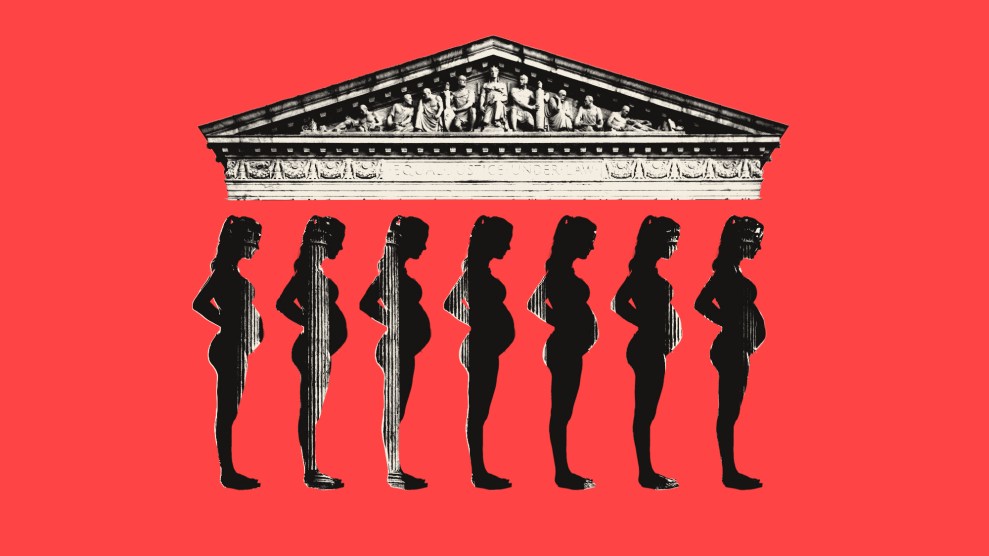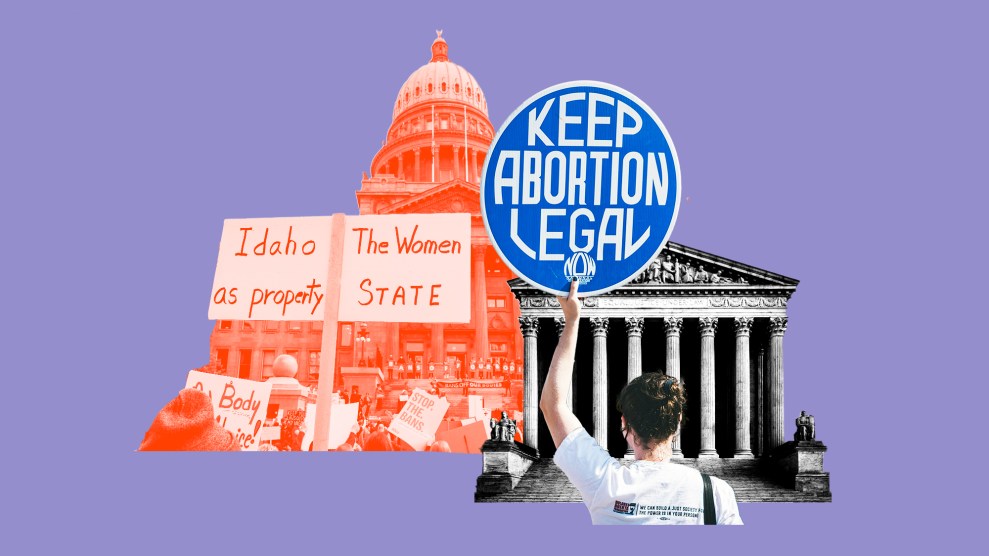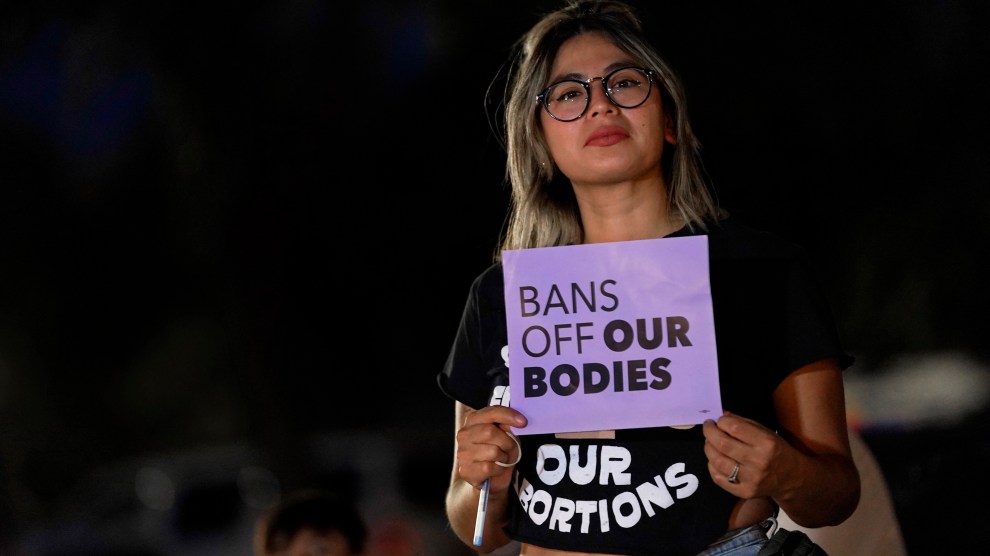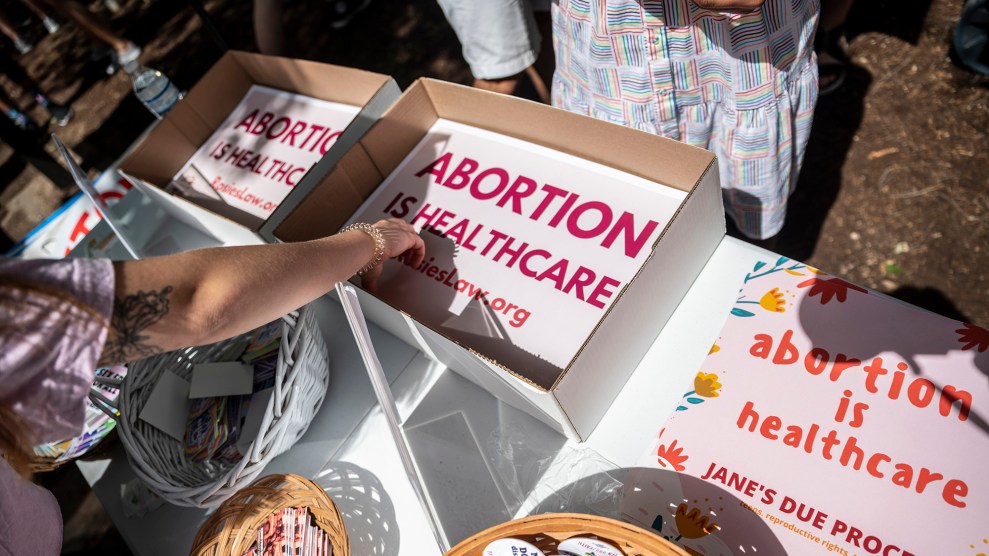
Mother Jones; Getty
Dr. Leilah Zahedi-Spung spent four years in medical school, four years in an OB-GYN residency, and three years in a maternal-fetal medicine fellowship learning how to care for high-risk pregnant patients. In her decade-plus of medical training, she learned that in some cases, the only rational and responsible option for medical intervention is an emergency abortion. In July 2021 she moved to Chattanooga, Tennessee, and discovered she was the sole provider in her area trained to perform second-trimester dilatation and evacuation abortions for patients who needed them to survive.
But in 2022, the Supreme Court delivered its Dobbs v. Jackson Women’s Health Organization decision, and Tennessee’s trigger ban—written in preparation for the possibility that the Supreme Court would overturn Roe—went into effect a month later. Suddenly, providing an abortion in Tennessee became an immediate Class C felony punishable by up to 15 years in prison. There were no exceptions, even when an abortion was necessary to save a life or prevent serious bodily harm. Only after being arrested could a physician provide something called an “affirmative defense” to fight the charges. (Eight months after the trigger law took effect, the GOP governor signed a bill allowing abortions in limited medical emergencies.)
Given her unique work, which also includes genetic testing and live deliveries, Zahedi-Spung felt as if she wore a bull’s-eye on her back. She hired a criminal defense attorney—just in case—and immediately began looking for a maternal-fetal medicine position out of state. She didn’t want to leave Tennessee at all, she says, but her goal was “to not go to jail.”
Relocating for work isn’t a novel concept, but in the age of unfettered abortion restrictions, there has been an exodus of OB-GYNs from abortion-banned states, and dwindling interest among future OB-GYNs to settle in those states. The result is worsening health outcomes for the vulnerable patients and moms who remain.
“As more clinicians leave those states, as more maternity care deserts happen, we will see poorer outcomes,” says Dr. Stella Dantas, an OB-GYN in Oregon and the president-elect of the American College of Obstetricians and Gynecologists. “And I do think we will see more maternal mortality just by the sheer fact that we won’t have providers even trained to take care of some of these obstetric emergencies.” Indeed, 64 percent of practicing OB-GYNs who responded to a KFF (formerly the Kaiser Family Foundation) survey said the Dobbs ruling has worsened maternal mortality.
In the before times, a high-risk obstetrics patient might consider having an abortion to nearly eliminate their potential maternal health risks, or even just seek more frequent monitoring to decrease them. But what happens when there are fewer clinicians left to treat sicker pregnant patients—and higher numbers of them—as birth rates rise in abortion-banned states? Data from states tell the story.
Even before outright abortion bans, the states that eventually restricted the medical procedure had higher rates of pregnancy-related deaths, sicker patient populations, and less access to maternal and preventative health care, according to data from KFF and Surgo Ventures, a nonprofit that researches health and social issues.
Since the Supreme Court’s June 2022 opinion that overturned nearly 50 years of legal abortion in the US, the poor care infrastructure in some states that culminated in bad maternal outcomes has only gotten worse. In Idaho, for example, which bans nearly all abortions, 22 percent of OB-GYNs have relocated outside the state, and today, half of Idaho’s 44 counties are now without any practicing obstetricians. Texas saw 10 percent fewer medical students apply to its OB-GYN residencies in the application cycle following Dobbs. Nearly 60 percent of third- and fourth-year medical students who responded to a recent survey said they were unlikely to apply to residency programs, across all specialties, in states that restrict abortion. In Alabama, which ranked highest in the nation in a Maternal Vulnerability Index and has one of the worst maternal mortality rates in the developed world, at least three birthing centers have closed in the last year.
“It’s not just going to affect abortion care or even maternity care,” says Dantas. In addition to providing prenatal and postnatal care, OB-GYNs are also needed to test for and treat sexually transmitted infections, screen for various cancers, and more. People in maternal health deserts are now looking at the possibility of even further commutes simply to access a gynecological provider for routine and preventative medical care.
“People don’t necessarily love to go in for a Pap smear,” Dantas adds. “Are you going to drive hundreds of miles out of your way to get a Pap smear?”
The care deserts will disproportionately affect low-income people and people of color. In her new maternal-fetal health role in Colorado, Zahedi-Spung says many of her dilatation and evacuation patients travel to her from Texas, Oklahoma, and Idaho because of unworkable abortion laws there. Given the current reproductive health care landscape, they are the lucky ones. She fears others in abortion-restricted states lack the resources to travel.
“We know that privileged people will always have access to abortion. We know that they will always have access to health care,” says Monica Simpson, the executive director of Sister Song, one of the oldest reproductive justice organizations in the country. For everyone else, Simpson says, “thousands of people are falling through the cracks.”
Further, the states restricting abortion are also less likely to have social support benefits to help moms and children. For example, 10 of the 13 states that rejected federal funds for low-income kids to get summer food assistance have banned abortion, either beyond six weeks or at conception. “Those same people who are anti-choice are the ones who want to cut welfare,” says Zahedi-Spung. “They’re the same ones who don’t want to provide food stamps. They’re the same ones who don’t want to expand birth control options.”
Socioeconomic and environmental conditions affect everyone’s health, but especially the health of pregnant people. “All of those policies play into how someone receives care and what their health looks like going into a pregnancy,” Zahedi-Spung adds. “The sicker you are going into a pregnancy, the sicker you will be coming out of it.”
Without intervention, this is only the beginning of a downward spiral. The KFF survey showed more than half of practicing OB-GYNs reported worrying that the increasingly daunting legal landscape will attract fewer future providers. Had she known the challenges she’d face in trying to provide care, Zahedi-Spung says, “I don’t know that I would have gone to medical school.”
Short of reversing Dobbs, advocates say, some options remain. Maternal health issues could be eased by expanding Medicaid in the states that have not done so, such as Alabama and Texas, to enable more people to access birth control and health care before getting pregnant. Additionally, Dantas says, the federal government should consider increasing clinician reimbursements for Medicaid, which finances about four in 10 childbirths in the US, but often at rates that cover less than half of what it costs to care for birthing patients. When clinics can’t cover their overhead, they can’t hire sufficient staff, says Dantas. Or, they shut down.
But policymakers want more than anecdotes about poor outcomes before making funding decisions that could improve them. They want data, Dantas says. While tracking maternal outcomes is vital work, the state boards that compile such figures are largely made up of local volunteer clinicians who now bear more responsibility than ever at their day jobs.
“You want to ask those 12 doctors who are seeing all of the patients for the entire state, and navigating an abortion ban, to—on their free time—get together, and view all the deaths in the state?” says Zahedi-Spung. “That’s just not a tenable situation.”
Today, a little over a year after she moved to Colorado, Zahedi-Spung is still haunted by the life and the hundreds of would-be patients she was forced to leave behind. “It was one of the hardest decisions I’ve ever made,” she tells Mother Jones. “I will probably be working through the grief and guilt of it for the rest of my life.”

















